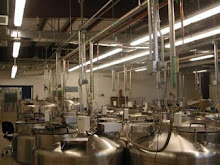Thursday, September 4, 2008
How Cold is Cold???
Liquid Nitrogen is -196 Centigrade, -320 Fahrenheit. Your skin is about 99 Fahrenheit. So we have about a 420 degree difference between skin and LN2. Now, LN2 IS dangerous, it is used to basically freeze off warts, moles, etc. It burns. However, it actually takes longer than you think to do this. Essentially, to burn the skin you have to drain the energy (heat) out of the it using LN2. A splash of LN2 is on your skin for just a fraction of a second, in that time, very little energy was actually lost and the LN2 has basically flashed off, so you need more LN2 to cool the skin. Couple this with the layer of oil that is on your skin that the LN2 has to cool down and/or move first, and you'd be amazed at how you can pull a dollar bill out of a container of LN2 with your bare hands never even getting wet?
Tuesday, September 2, 2008
Liquid Nitrogen: Under Pressure
Liquid Nitrogen, or LN2, expands to something like 700 times (estimate) its capacity from a liquid to a gas. This means that if you put 1 liter of liquid nitrogen into a space, seal it, then the LN2 warms to a gas, it's going to expand to around 700 liters of nitrogen gas when it reaches 70 degrees F. Basically, without knowing it, someone may create a pressure bomb that can be VERY, VERY dangerous. For this reason we have pressure relief devices (PRDs) on all LN2 systems; when the pressure in the system exceeds the PRDs limit, the PRD vents the excess gas out of the system, thereby maintaining a specific pressure in the system. Without this, things would definitely explode. For instance, a small amount of LN2 inside a capped plastic soda bottle would definitely take your hand off if you were holding it.
Subscribe to:
Comments (Atom)
